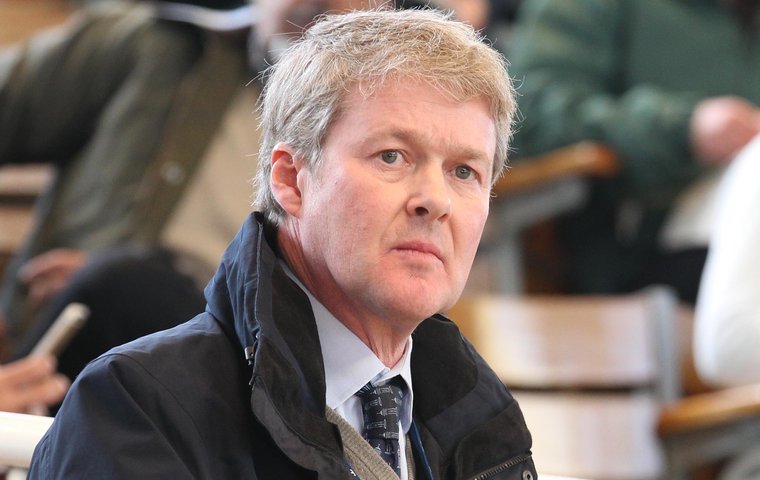
When Richard Tattersall established his eponymous Sales operation at London’s Hyde Park Corner over 250 years ago, he could scarcely imagine that it would become the oldest bloodstock auctioneers in the world and the largest in Europe.
In that quarter of a millennium, it has grown exponentially and it now boasts 15 sales at either its Newmarket headquarters in England or at Fairyhouse in Ireland - including the important Craven Breeze-Up Sale taking place this week. Book 1 of its annual October Sale is Europe’s premier yearling auction, which is often a source of European Classic and Group winners. In the past decade four Epsom Derby winners have come from the sale.
As director of marketing, Jimmy George is tasked with making sure that around 10,000 Thoroughbreds offered each year remain of the highest calibre, and ensuring that the human talent is of a similar ilk. He is often seen as a public face of Tatts and is a conspicuous presence at sales across the globe.
George started work at Tattersalls in the bloodstock department on leaving university in 1986 before joining the ‘Thoroughbred Breeder’ magazine and ‘Directory of the Turf’ three years later, ultimately becoming editor of ‘Pacemaker’ magazine.
He returned to Tattersalls in 1994 as marketing manager and became marketing director in 2001.
Who do you think is the most important figure in world racing history?
The key word here is ‘history’. There have been a number of hugely influential figures in the sport since I became involved in the mid-1980s and they will leave lasting legacies, but historically the impact of King Charles II deciding to make Newmarket his playground in 1666 has been extraordinary.
The royal patronage ensured that Newmarket became the established focal point for horseracing, and the town is still widely regarded as the global headquarters of Thoroughbred racing and breeding more than 350 years later. It showcases every single aspect of the sport. There are two racecourses hosting a number of breed-defining races, some of the world’s pre-eminent owner-breeders have their global bases standing many of the world’s leading sires in Newmarket. Almost 3,000 horses in training and more than 70 trainers use the same historic turf that attracted King Charles II to the town, and numerous stud farms, vets, farriers, shippers, bloodstock agents, insurance providers and of course Tattersalls are also among those to be found in or around the East Anglian town with a population of less than 20,000.
Which is your favourite venue and race anywhere in the world?
Epsom would not be my favourite racecourse, but the Derby is the holy grail for me. It remains a true test for a 3-year-old and so many Derby winners have gone on to be among the most influential sires in the history of the breed, not least relatively recent winners Galileo and Sea The Stars, as well as an extraordinary three in a row at a slightly earlier stage of my life - Nijinsky, Mill Reef and Roberto, winners in 1970, 1971 and 1972 respectively.
For a combination of beauty and top-class racing, Goodwood is hard to beat and it was where I had my first experience as a winning owner. I just wish it was easier to get to from Newmarket.
What is your fondest memory in racing?
Probably the 2007 Group 2 Beresford Stakes at the Curragh, which was won by a colt called Curtain Call, who I part owned with two very good friends, Patrick Cooper and Bill Oppenheim.
On his previous start Curtain Call had split New Approach and Henrythenavigator in the Group 2 Futurity Stakes (also at the Curragh), so we knew we owned an above-average horse, but, when he won the Beresford by four lengths, it was beyond all expectation. We were all at the Curragh that day, which made it even more special.
A close second was a few years later [2015] when we won the Grade 1 Rodeo Drive at Santa Anita with our filly Photo Call (see video below), but the European sales season was in full swing so none of us were able to be there. It was still a huge night and by some margin the biggest thrill I have ever had staring at a computer screen.
What do you see as the biggest challenge racing faces today?
In the UK, it remains the seemingly endless quest for a robust, sustainable funding model for the sport, but globally it seems to me that the greatest challenge is to attract racegoers in larger numbers.
Going racing is the basic entry point to the sport. The first-time racegoer may turn into a committed fan, progress to becoming an owner or breeder, or remain as an infrequent social racegoer. All are key participants in the sport and the chances are that any lasting involvement will have been ignited by the first racecourse experience.
As ever identifying challenges is easier than identifying remedies, but the more free-to-air terrestrial TV coverage the sport can generate the better. This is one area where Britain does not lag behind the rest of the world. We must keep it that way.
If you could change one thing in racing, what would it be?
Racing is a global sport and it should have a global set of rules covering stewarding, medication, use of the whip, everything. A monumental task, maybe even an unrealistic one, but the recent passing of the Horseracing Integrity and Safety Act in the U.S. surely gives some cause for optimism. If America can eventually formulate one set of rules covering the most important aspects of the sport, next stop the world.


